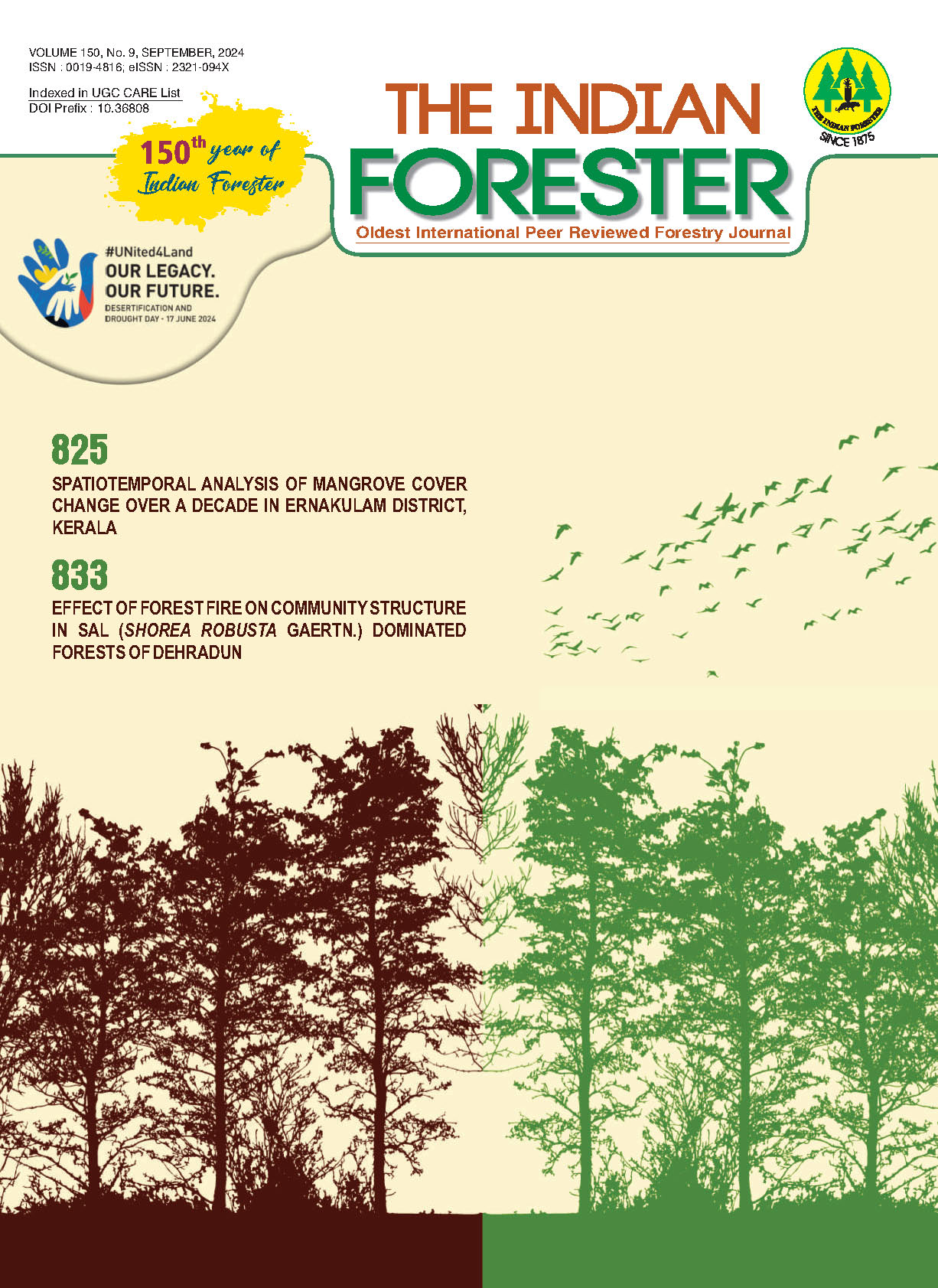Monitoring Forest Cover Change of Gorumara National Park Using Landsat Data
DOI:
https://doi.org/10.36808/if/2024/v150i9/169674Keywords:
Forest Canopy Density, Change Detection, Remote Sensing, Landsat 8, Gorumara National Park.Abstract
An important method for monitoring changes in forest cover involves combining remote sensing with geographic information systems (GIS). Using remote sensing and GiS to map forest cover is a cost-effective assessment method. This study aims to monitor and identify forest cover changes using the forest canopy density (FCD) modei in Gorumara National Parif, which spans 79.99 krtf area. Landsat 8 sateiiite imagery was used to generate FCD maps over a five-year period, from 2016 to 2021. QGiS software was used for radiometric correction, image processing and mapping. Bare son index (BSi), Advanced vegetation index (AVI) and shadow index (SI) were calculated for FCD mapping. Withan overall l(appa statistic of 0.88, the FCD classification accuracy was 91.26%. The final results Indicate that the total forested area increased by 13.25%. The areas under very dense forest (0.49 km2), moderately dense forest (0.43 km2), open forest (0.96 km2) and scrub (2.36 km2) In the non-forest category show a very low rate of deforestation.References
Akike s. and Samanta S. (2016). Land Use/Land Cover and Forest Canopy Density Monitoring of Wafl-Golpu Project Area, Papua New Guinea, Journal of Geoscience and Environment PmtectionA'-1-14,doi: 10.4236/gep.2016.48001.
Almalki R., Khaki M., Saco P.M. and Rodriguez J.F. (2022). Monitoring and Mapping Vegetation Cover Changes in Arid and Semi-Arid Areas Using Remote Sensing Technology: A Review. Rem ote Sensing, 14(20): 5143. https://doi.org/10.3390/rs14205143.
Amin Y. (2016). Forest cover assessment and change detection analysis using remote Sensing and GiS in Pir Panjai Forest division of Kashmir Himalayan region. M.Sc. thesis Submitted to The Faculty of Forestry Sher-e-Kashmir University of Agricultural Sciences & Technoiogy of Kashmir. 29-33.
Anon (1998). Management Plan of Gorumara National Park, West Bengal. Wildlife Circle, Govt. of West Bengal, 81.
Azizi Z., Najafi A. and Sohrabi H. (2014). Forest canopy density estimating using satellite images. The International Archives of Photogrammetry, Remote Sensing and Spatial Information Sciences, 37:1127-1130.
Bera B., Bhattacharjee S., Sengupta, N. and Saha S. (2021). Dynamics of deforestation and forest degradation hotspots applying geo-spatial techniques, apaichand forest in terai belt of himalayan foothills: Conservation priorities of forest ecosystem. Remote Sensing Applications: Society and Environment, 22(1-3). doi: 10.1016/j.rsase.2021.100510
Bera B., Saha S. and Bhattacharjee S. (2020). Estimation of Forest Canopy Cover and Forest Fragmentation Mapping Using Landsat Satellite Data of Silabati River Basin (India). KN-Journal of Cartography and Geographic Information, 70: 181Â197.10.1007/342489-020-00060-1.
BirdLife International (2023). Important Bird Area factsheet: Gorumara National Park. Accessed from: http://datazone.birdlife.org/site/factsheet/18457, Accessed on: 25th May2023.
Champion H.G. and Seth S.K. (1968). Forest Types of India. Government of India Publication, Delhi. 404.
Congalton R.G., Oderwald R.G. and Mead R.A. (1983). Assessing Landsat classification accuracy using discrete multivariate statistical techniques. Photogrammetric Engineering and Remote Sensing. 49(12): 1671-1678.
Deka J., Tripathi O.P. and Khan M.L. (2012). Implementation of Forest Canopy Density Model to Monitor Tropical Deforestation. Journal of Indian Society of Remote Sensing, 41: 469-475. http://dx.doi.org/10.1007/s12524-012-0224-5.
FERN (2017). Tackling deforestation and forest degradation: a case for EU action in 2017, NGO statement, 1-2.
FSI (2021). India State of Forest Report, Forest Survey of India, Dehradun. Ministry of Environment and Forests, Govt, of India.
Huemmrich K.F. (1996). Effects of shadows on vegetation indices. International Geoscience and Remote Sensing Symposium, 4: 2372-2374. doi: 10.1109/IGARSS.1996.516990.
Loi D.T, Chou T-Y. and Fang Y-M. (2017). Integration of GIS and Remote Sensing for Evaluating Forest Canopy Density Index in Thai Nguyen Province, Vietnam. Intemational Journal of Environmental Science and Development. 8(8): 539-542. 10.18178/ijesd.2017.8.8.1012.
Lu D., Mausel P., Brondizio E.S. and Moran E. (2004). Change Detection Techniques. International Journal of Remote Sensing, 25(12): 2365-2407.
Mangan P. and Nandhini (2016). Forest Canopy Density and ASTER DEM based Study for Dense Forest Investigation using Remote Sensing and GIS Techniques. International Journal of Research in Environmental Science and Technology, 6(1): 1-4.
Pladsrichuay S., Suwanwerakamtom R. and Pannucharoenwong N. (2018). Estimating Vegetation Canopy Density in the Lower Chi Basin, Northeast, Thailand Using Landsat Data. Intemational Journal of Applied Engineering Research, 13(6): 3215-3219.
Riklmaru A. and Miyatake S. (1997). Development of forest Canopy Mapping and Monitoring Model using Indices of Vegetation, Bare soil and Shadow. Proceeding of the 18th Aslan Conference on Remote Sensing. Kuala Lumpur, Malaysia, 6:1-6.
Rikimaru A., Roy P.S. and Miyatake S. (2002). Tropical Forest Cover Density IVIapping. International Society for Tropical Ecology, 39-47.
Rikimaru A., Utsuki Y. and Yamasliita S. (1999). Basic study of tlie maximum logging volume estimation for consideration of forest resources using time series FCD (forest canopy density) model, in: Harris r. (ed.): Asian conference on remote sensing, Manila, nov 16-20,1998:6.
Rikimaru (1996). LANDSAT TM Data Processing Guide for forest Canopy Density Mapping and Monitoring Model. ITTO workshop on utilization of remote sensing in site assessment and planning for rehabilitation of logged-over forest. Bangkok, Thailand, July 30-August 1,1996.1-8.
Roy P.S., Sharma K.P. and Jain A. (1996). Stratification of density in dry deciduous forest using satellite remote sensing digital data - an approach based on spectral indices. Journal of Biosciences. 21(5): 723-734. https://doi. org/10.1007/BF02703148.
SarkarA., Sarkar S. and Das A.P. (2009). Change of vegetation structure in Gorumara National Park due to anthropogenic interferences. Journal of Plant Sciences, 3:71 - 76.
Shamshad M., Alam S., Khan J.A., Pathak B.J. and Kumar S. (2014). Assessment of forest density using geospatial techniques of a tropical protected area. International Journal of Scientific and Research Publications, 4(3): 1-6.
Singh A. (1989). Digital Change Detection Techniques Using Remotely-Sensed Data. International Journal of Remote Sensing, 10:989-1003.
Downloads
Downloads
Additional Files
Published
How to Cite
Issue
Section
License
Unless otherwise stated, copyright or similar rights in all materials presented on the site, including graphical images, are owned by Indian Forester.





